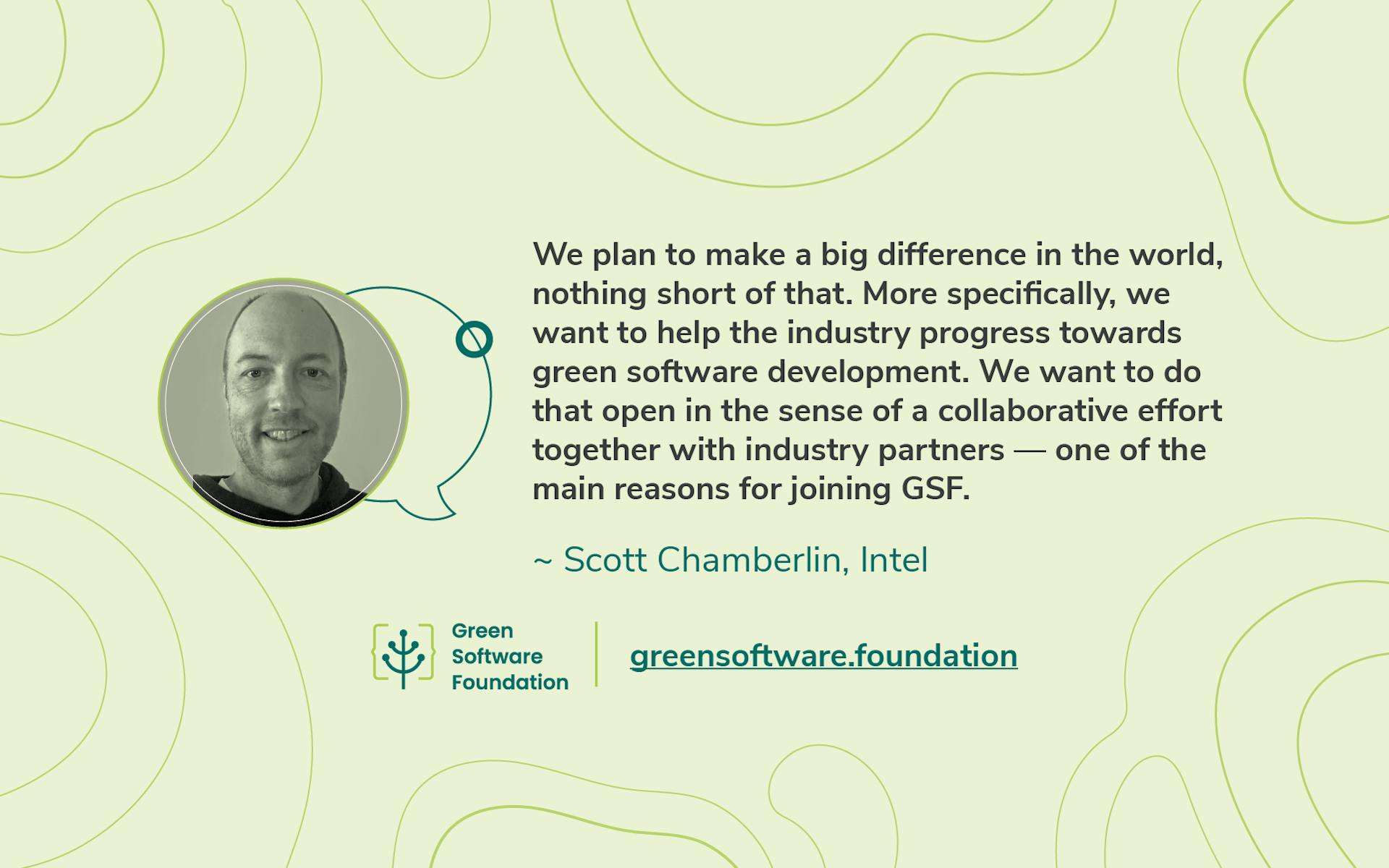Meet Scott Chamberlin, Sr Director of Sustainability at Intel
In April 2022, Intel announced its plans to reduce its greenhouse gas emissions further and develop more sustainable technology solutions. The pledge involves working with stakeholders and industry partnerships to find green solutions for the entire technology ecosystem. Hence, joining the Green Software Foundation is a natural step for Intel. Scott will complement the GSF Steering Committee with his two decades of software development experience.
What is your role today, and how did you get there?
As part of the Sustainability Office, I lead the green software efforts at Intel. We believe we can significantly impact greening software, and doing so as quickly as possible is critical. We are determined to find ways of adjusting software behavior to lower total carbon output.
Before starting the role at Intel, I did something similar at Microsoft. Passionate about sustainability, I asked myself if it was possible to influence how the world’s PCs used power and whether that would have a large enough impact to make a difference. I started by building models, creating initial prototypes, and measuring how much CO2 the PCs were emitting in terms of their energy usage. It turned out that the numbers were pretty significant. Encouraged by that, I built up partnerships at Microsoft, and we started looking at a variety of things we could do at the OS level to improve PC power utilization and, through power utilization, lower carbon emissions.
And then, we got introduced to the idea of carbon awareness, which doesn't necessarily change the level of power utilization, but the timing of power usage. We started building out capabilities on scheduling based on carbon awareness. Today, this allows for windows updates to run when the carbon intensity of the power supply is at its lowest level.
I find it fascinating how you started with the hardware's energy efficiency and then quickly realized the software needed to play a more prominent role.
Yes. And I think that's one of the big gaps we see in the industry. Accounting for carbon emissions is associated with the hardware primarily. However, the reality is that software development vastly controls how the hardware utilizes power. So, I think if you're going to pick a lever to pull, do it on the software development side. But how do you account for software CO2 emissions? One of the challenges will be to quantify those.
I associate Intel primarily with processors; is that wrong?
That's not wrong. Intel's primary business is processors, as well as data centers. But we realize that users interact with computing mainly through software. So, the new Intel strategy is a software-first approach. How do we lead with software experiences? How do we ensure we get the customer experiences right and add value where the customers interact with their devices or enterprises interact in the cloud? Adding value means taking that information and applying it to our hardware to make it shine.
What is your mission in the sustainability and green software context, and why did you join GSF?
We plan to make a big difference in the world, nothing short of that. More specifically, we want to help the industry progress towards green software development. We want to do that open in the sense of a collaborative effort together with industry partners—one of the main reasons for joining GSF.
Our strategy at its core is to operate through open source. That implies a couple of things. One, it helps us align our partners with our goals to a certain degree. We view the Green Software Foundation as one of the main hubs where people are talking about the capabilities of green software. Being on board also means streamlining our own goals with the other industry partners, which brings enormous benefits to all participating organizations.
The other thing with open source is that it accelerates what you can accomplish. You're not necessarily limited by the thinking of one company alone, but you have other partners with whom you can weigh things. It’s an excellent opportunity for us to get a different perspective; vice versa, Intel can help other partners. This reciprocal process speeds up learning, helping us find solutions to this issue as quickly as possible. We don't have the luxury of waiting around. The amount of electricity consumed in data centers, PCs, and IoT devices is snowballing. Whatever we do now will have an exponential impact on CO2 associated with software use. We need to play our part, and the time is now.
With the general increase in software usage and the immense growth in user numbers today, it certainly sounds like you can set the stage for tremendous energy savings down the road. I am also intrigued by how you value the collaborative aspect, where results are achieved by working together.
A tangible impact can only be achieved with all the industry partners at the table. To get results, you have to do it at scale. Like an individual device doesn't use much power. But if you effect change across the world’s data centers, you are looking at a substantial impact. If you save energy across the world’s PCs, if it happens across the IoT devices of the world, that’s how we will make a significant contribution towards net zero.
And the only way to get there is by meeting developers from various sectors, be it the cloud providers, PC makers, etc. That's where Intel is in a fantastic position in the marketplace. We foster excellent business relationships with all these groups and organizations.
Do you have a vision of where the journey will go? Is there a specific issue that you want to emphasize?
To a large extent, green software means making it more carbon-efficient, ensuring it uses energy more intelligently, and using hardware more effectively. We want to see this as a standard, a fundamental aspect of software development. We see security, reliability, or accessibility take center stage for developers. The sustainability aspect needs the same attention; we want it to be a ubiquitous component in software.
Part of the focus will have to be on education and raising awareness. We need to ensure developers realize which pivotal role they can play in fostering environmental sustainability. Then obviously, we want to find ideas for best practices on how software can be optimized for higher energy efficiency. While customer value and needs are front and center, there's much room for how software behaves with regard to CO2 efficiency.
One of the challenges is the amount of existing software already deployed. How do you handle that? Thankfully, most software changes over time and does get updated. So, updates become an opportunity for incorporating sustainability components. Another big challenge is the sheer number of different platforms, which complicates a uniform approach.
There is also a lot of pressure on developers already. They are burdened with much more than 20 years ago when I started in software development. Security concerns today are much more sophisticated than they were back then. We need to make sure that while we make software more green, it doesn’t necessarily become a burden on developers. Solutions need to be easy to implement and ensure the highest impact for the lowest amount of developer involvement. I think that’s super important.
Which GSF working groups will you be involved in?
I think the standards working group is exciting. The key is to have a standard in place on how to measure carbon emissions. I like the carbon intensity work from GSF so far. How do you quantify, and how do you put actual numbers behind it? I think that’s the fundamental building block we need to adopt broadly to start making progress in this space.
We have to raise awareness to get a broader consensus. It also includes communication toward expectations and value. For instance, what's the value of adopting the standard? What's the value in understanding the carbon intensity of your software and driving it down? When we talk about aggregate capabilities, there's an enormous opportunity here.
This article is licenced under Creative Commons (CC BY 4.0)

